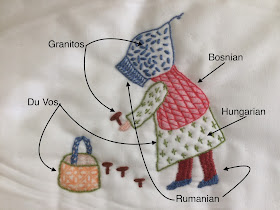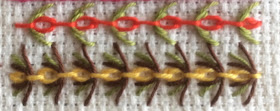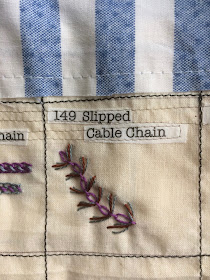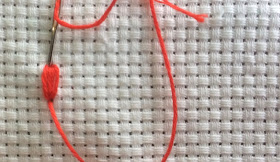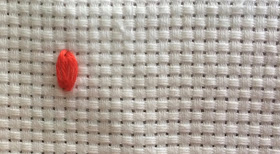TAST stands for Take A Stitch Tuesday which is an online course of stitches on Sharon Boggon's Pintangle. Join in and learn. If you want to do it from scratch, there will be a rerun starting next year.
Read more about it here.
Learn Beaded Oyster Stitch here.
As I have explained before, I want all the TAST stitches in one (private) collection and will give them the chronological number in the order I learn them.
So now it is time for Beaded Oyster Stitch, which I will call TAST #151.
Pages
▼
Tuesday, 31 October 2017
Sunday, 29 October 2017
Sunday Stitch School - Lesson 41: Thorn Stitch
Here we are again in the Biology classroom at Sunday Stitch School.
Take out your Flora and look at the Thorn Stitch.
Latin name: Suo Spinam
Japanese name: ソーンステッチ
Swedish name: Taggsöm
French name: Couchure au point d'épine
You need two threads, one to lay on the surface and another to couch it down, like this:
(Of course you can also use a braid, ribbon, wire or anything you want to couch down.)
Then couch it down with a 'cross stitch':

Your
Homework
will be to add some Thorn Stitch to this sampler, which already feature X-Ray Stitch and Whipped Running Stitch.
Take out your Flora and look at the Thorn Stitch.
Latin name: Suo Spinam
Japanese name: ソーンステッチ
Swedish name: Taggsöm
French name: Couchure au point d'épine
You need two threads, one to lay on the surface and another to couch it down, like this:
(Of course you can also use a braid, ribbon, wire or anything you want to couch down.)
Then couch it down with a 'cross stitch':
On the Aida sampler I used the same thread, and instead of a good contrast I got a nice 'barbed wire'!
Your
Homework
will be to add some Thorn Stitch to this sampler, which already feature X-Ray Stitch and Whipped Running Stitch.
Friday, 27 October 2017
Friday Revision Homework - Stitches 36 - 40
This Friday I am handing in a revision homework for the last five Sunday Stitch School's stitches.
Sunbonnet Sue was once a little girl who went to the woods picking mushrooms to cook soup for her grandmother who was ill in bed.
Sue remembered the bedtime fairy tales her mother had read her and knew better than to put on her red riding hood.
Instead she put on a blue bonnet, and the Big Bad Woolf was cheated out of his 'dinner'.
Clever Sue!
Sunbonnet Sue was once a little girl who went to the woods picking mushrooms to cook soup for her grandmother who was ill in bed.
Sue remembered the bedtime fairy tales her mother had read her and knew better than to put on her red riding hood.
Instead she put on a blue bonnet, and the Big Bad Woolf was cheated out of his 'dinner'.
Clever Sue!
Wednesday, 25 October 2017
WIPW - Mola Progress
It is Wednesday and time to report progress on Work in Progress Wednesday.
Mola
I have needle turned all the 'Florida Blue' batik and the leaf patterned batik, also from Floria, is visible.
There's a bit of purplish batik ('pasta' remnants from Trinity Green!) at the ground and a triangle of yellow sticking out.
Mola - Snippets of Interest
The Cuna Indians of San Blas Islands believe in a life after death. Cuna women who make beautiful Molas are ensured a place in a special house in heaven.
(Source: Eva Köhlmark - Broderiboken)
Traditional Mola motifs often feature mirrored images, this tradition originates in the belief that everything comes in pairs, is the same and yet different, e.g. left and right, man and woman...
(Source: Elizabeth Healey - Stitch, Fabric & Thread (which is an excellent book))
Greeting Card
I used the outline of the oak leaf and acorn that was my homework for the Du Vos Stitch

and filled it with straight stitches and French Knots.
Mola
I have needle turned all the 'Florida Blue' batik and the leaf patterned batik, also from Floria, is visible.
There's a bit of purplish batik ('pasta' remnants from Trinity Green!) at the ground and a triangle of yellow sticking out.
Mola - Snippets of Interest
The Cuna Indians of San Blas Islands believe in a life after death. Cuna women who make beautiful Molas are ensured a place in a special house in heaven.
(Source: Eva Köhlmark - Broderiboken)
Traditional Mola motifs often feature mirrored images, this tradition originates in the belief that everything comes in pairs, is the same and yet different, e.g. left and right, man and woman...
(Source: Elizabeth Healey - Stitch, Fabric & Thread (which is an excellent book))
Greeting Card
I used the outline of the oak leaf and acorn that was my homework for the Du Vos Stitch

and filled it with straight stitches and French Knots.
It was then mounted on a piece of cardboard and inserted into a window card, and is now winging its way to a friend's birthday celebration.
Tuesday, 24 October 2017
TAST 150: Whipped Spoke Stitch
TAST stands for Take A Stitch Tuesday which is an online course of stitches on Sharon Boggon's Pintangle. Join in and learn. If you want to do it from scratch, there will be a rerun starting next year.
Read more about it here.
Learn Whipped Spoke Stitch here.
As I have explained before, I want all the TAST stitches in one (private) collection and will give them the chronological number in the order I learn them.
So now it is time for Whipped Spoke Stitch, which I will call TAST #150.
This stitch is very similar to TAST 11 Whipped Wheel, but I made a band instead of a wheel.
First on Aida,
then on canvas
and finally on the TAST Reference Chart.
Read more about it here.
Learn Whipped Spoke Stitch here.
As I have explained before, I want all the TAST stitches in one (private) collection and will give them the chronological number in the order I learn them.
So now it is time for Whipped Spoke Stitch, which I will call TAST #150.
This stitch is very similar to TAST 11 Whipped Wheel, but I made a band instead of a wheel.
First on Aida,
then on canvas
and finally on the TAST Reference Chart.
Sunday, 22 October 2017
Sunday Stitch School - Revision: Stitches 36 - 40
Welcome to Sunday Stitch School. The rain is pelting down here, so it is the perfect opportunity to stay indoors and study stitches!
Once again it is time for another revision lesson to sum up the last five stitches.
Click on the headline to see instructions and homework.
37 Hungarian Stitch
This stitch makes such a lovely pattern on canvas.
Once again it is time for another revision lesson to sum up the last five stitches.
Click on the headline to see instructions and homework.
I have found another name for this stitch: New England Laid Stitch.
It is great for filling, makes a nice 'Satin Stitch' look and does not need a Split Stitch outline.
This stitch makes such a lovely pattern on canvas.
Easy and quick.
Oh, how easy it is to make swelling flower buds, seeds and pebbles!
This is an unusual stitch, great for outlines and other linear work.
Revision Homework:
Stitch this Sunbonnet Sue sampler, 'cheat' with crayons and molding mat.
Friday, 20 October 2017
Friday Homework for Lesson 40: Du Vos Stitch
Here is my homework for the Du Vos Stitch, the #40 of Sunday Stitch School's collection.
As it is an 'outline' stitch, I used it to 'draw' the edges of an oak leaf and three acorns.
As it is an 'outline' stitch, I used it to 'draw' the edges of an oak leaf and three acorns.
The fabric is kimono silk, and the thread two strands of DMC floss.
This is a UFO, and I will fill in the leaf and acorns, turn it all into a greeting card. The picture will be posted on Wednesday for the WIPW.
...............
Now, with these pictures I want to clarify the difference between the Du Vos Stitch, Stem Stitch and Outline Stitch.
Thursday, 19 October 2017
WIPW - MOLA - Revealing the Fabric Underneath
Work In Progress Wednesday.
MOLA
I have had very limited time to work on my Mola, but have started revealing the first layer of fabric underneath the black top.
This blouse is part of the folk costume worn by the women of the Cuna Indians on the San Blas Islands in Central America.
Onto the highly decorative square panel, a yoke and sleeves are attached.
Traditionally the Cuna Indians used paint to decorate their bodies. When they got in contact with Westerners (Spanish colonists and missionaries), and thereby also had access to fabric, the geometric designs were worked on blouses instead.
(Sources: Hemmets HandarbetsLexikon, Eva Köhlmark: Broderiboken, Elizabeth Healey: Stitch, Fabric & Thread)
MOLA
I have had very limited time to work on my Mola, but have started revealing the first layer of fabric underneath the black top.
I have also appliquéd the black cut out part of the leaf and one flower.
More excavating of fabric underneath next week.
MOLA - Snippets of Interest
If you are a quilter, when you hear the word Mola, you might instantly think of colourful quilts of reverse appliqué. Actually the name Mola means blouse or garment.This blouse is part of the folk costume worn by the women of the Cuna Indians on the San Blas Islands in Central America.
Onto the highly decorative square panel, a yoke and sleeves are attached.
Traditionally the Cuna Indians used paint to decorate their bodies. When they got in contact with Westerners (Spanish colonists and missionaries), and thereby also had access to fabric, the geometric designs were worked on blouses instead.
(Sources: Hemmets HandarbetsLexikon, Eva Köhlmark: Broderiboken, Elizabeth Healey: Stitch, Fabric & Thread)
Tuesday, 17 October 2017
TAST 149: Slipped Cable Chain Stitch
TAST stands for Take A Stitch Tuesday which is an online course of stitches on Sharon Boggon's Pintangle. Join in and learn. If you want to do it from scratch, there will be a rerun starting next year.
Read more about it here.
Learn the Slipped Cable Chain Stitch here.
As I have explained before, I want all the TAST stitches in one (private) collection and will give them the chronological number in the order I learn them.
So now it is time for Slipped Cable Chain Stitch, which I will call TAST #149.
Isn't it beautiful?
Read more about it here.
Learn the Slipped Cable Chain Stitch here.
As I have explained before, I want all the TAST stitches in one (private) collection and will give them the chronological number in the order I learn them.
So now it is time for Slipped Cable Chain Stitch, which I will call TAST #149.
Isn't it beautiful?
Sunday, 15 October 2017
Sunday Stitch School - Lesson 40 - Du Vos Stitch
Another Sunday and another stitch is upon us at Sunday Stitch School.
Do you remember I pleaded for help and asked for information about the '?-Stitch'?
Thank you so much for the feedback.
It is a good linear stitch and will be needed for the next Sunbonnet Sue (next week's lesson).
As no one has given me a name I will nick-name this stitch Du Vos Stitch in honour of the teacher who taught my friend. I think that name is better than Staggered Back Stitch, which is the only other name I could think of.
Work it like this:



On my Aida sampler:
Homework:
You are free to do whatever you like with this stitch, but please NO more poetry!
Do you remember I pleaded for help and asked for information about the '?-Stitch'?
Thank you so much for the feedback.
It is a good linear stitch and will be needed for the next Sunbonnet Sue (next week's lesson).
As no one has given me a name I will nick-name this stitch Du Vos Stitch in honour of the teacher who taught my friend. I think that name is better than Staggered Back Stitch, which is the only other name I could think of.
Work it like this:



On my Aida sampler:
Homework:
You are free to do whatever you like with this stitch, but please NO more poetry!
Friday, 13 October 2017
Friday Homework for Lesson 39: Granitos
Time to hand in Friday Homework for Sunday Stitch School.
This week the stitch is called Granitos, I guess Granito is singular, but then my Spanish has not improved since last Sunday!
Student:
If Granitos mean small grains,
then I can sew
Granito grains of sand,
green cacti Granitos,
with blue Granito flowers,
Chain stitched stems from where
purple Granito blossoms dangle,
and white Granito petals sprout,
while yellow Granito petals,
on top of Stem stitched stems
spread out from black Granito crossed centres....
Teacher:
Since when was your homework poetry?
The task was BIOLOGY!
Student:
But all these plants, and the sand, too, IS biology - flora and geology!
Teacher:
Well, at least your stitching is not as awful as your verse!
This week the stitch is called Granitos, I guess Granito is singular, but then my Spanish has not improved since last Sunday!
Student:
If Granitos mean small grains,
then I can sew
Granito grains of sand,
green cacti Granitos,
with blue Granito flowers,
Chain stitched stems from where
purple Granito blossoms dangle,
and white Granito petals sprout,
while yellow Granito petals,
on top of Stem stitched stems
spread out from black Granito crossed centres....
Teacher:
Since when was your homework poetry?
The task was BIOLOGY!
Student:
But all these plants, and the sand, too, IS biology - flora and geology!
Teacher:
Well, at least your stitching is not as awful as your verse!
Wednesday, 11 October 2017
WIPW - MOLA Try Outs and Preparation
Work In Progress Wednesday. This week I have only the new
MOLA
project to report on.
I also noticed that the fabric frays too much so I will opt for as much batik as possible for this project.


I polished the design sketch, made some notes
and marked the black top,
then basted the three layers together.
MOLA
project to report on.
Last week I had got this far on my sampler.
Since then I have made some of the slits with fabric inserted.
These long ones were easy.
With the triangles and squares I hit a problem; the pieces I inserted were a bit too scant, and as I also failed to place them exactly underneath the holes, raw edges peeped out!
From now on I will be using a pair of pointed tweezers to place the pieces correctly and hold them in place with a pin until the first edge is sewn down.
I also noticed that the fabric frays too much so I will opt for as much batik as possible for this project.

For the top layer, though, I will use the remains of the black sheeting I used to back Trinity Green, but I will fix the edges with fray guard at tricky points.

I polished the design sketch, made some notes
and marked the black top,
then basted the three layers together.
Tuesday, 10 October 2017
TAST 148: Whipped Double Chain Stitch
TAST stands for Take A Stitch Tuesday which is an online course of stitches on Sharon Boggon's Pintangle. Join in and learn. If you want to do it from scratch, there will be a rerun starting next year.
Read more about it here.
Learn it here.
As I have explained before, I want all the TAST stitches in one (private) collection and will give them the chronological number in the order I learn them.
So now it is time for Whipped Double Chain Stitch, which I will call TAST #148.
Read more about it here.
Learn it here.
As I have explained before, I want all the TAST stitches in one (private) collection and will give them the chronological number in the order I learn them.
So now it is time for Whipped Double Chain Stitch, which I will call TAST #148.
Sunday, 8 October 2017
Sunday Stitch School - Lesson 39: Granitos
Welcome to Sunday Stitch School.
On the request of a student, we are today changing to another subject, Biology, and will study grains.
We will cling on to Geography in a sense, and also branch into Geology and Languages.
Today's stitch is called Granitos.
Many sources claim it stands for little grain in Spanish. My online dictionary, though, says grain is called grano in Spanish, and granito means granit. Could it mean a grain of granit = sand?
I'd welcome feedback from any reader with knowledge of Spanish, or the origin of the name.
The only name I have found for this stitch in Japan is the 'Japanglish' プレーンナットステッチ, Plain Knot Stitch. This is totally incorrect as there is not one single knot involved, plain or (k)not!
Updated: Point de Granitos or Point de Petits Grains are the French names. Thank you Mattia.
On my Aida sampler the Granitos look like this:

Work it like this:
An odd number of straight stitches are worked between the same two holes.

Make one straight stitch,

place the second on the left,
the third on the right

and so on
building the stitch full and fat.
Mary Corbet at Needle 'n Thread has a nice video.
Annet has a nifty way to tame the thread.
Homework:
Use this stitch creatively. Remember this lesson is Biology!

On the request of a student, we are today changing to another subject, Biology, and will study grains.
We will cling on to Geography in a sense, and also branch into Geology and Languages.
Today's stitch is called Granitos.
Many sources claim it stands for little grain in Spanish. My online dictionary, though, says grain is called grano in Spanish, and granito means granit. Could it mean a grain of granit = sand?
I'd welcome feedback from any reader with knowledge of Spanish, or the origin of the name.
The only name I have found for this stitch in Japan is the 'Japanglish' プレーンナットステッチ, Plain Knot Stitch. This is totally incorrect as there is not one single knot involved, plain or (k)not!
Updated: Point de Granitos or Point de Petits Grains are the French names. Thank you Mattia.
On my Aida sampler the Granitos look like this:
Work it like this:
An odd number of straight stitches are worked between the same two holes.

Make one straight stitch,

place the second on the left,
the third on the right

and so on
building the stitch full and fat.
Annet has a nifty way to tame the thread.
Homework:
Use this stitch creatively. Remember this lesson is Biology!












